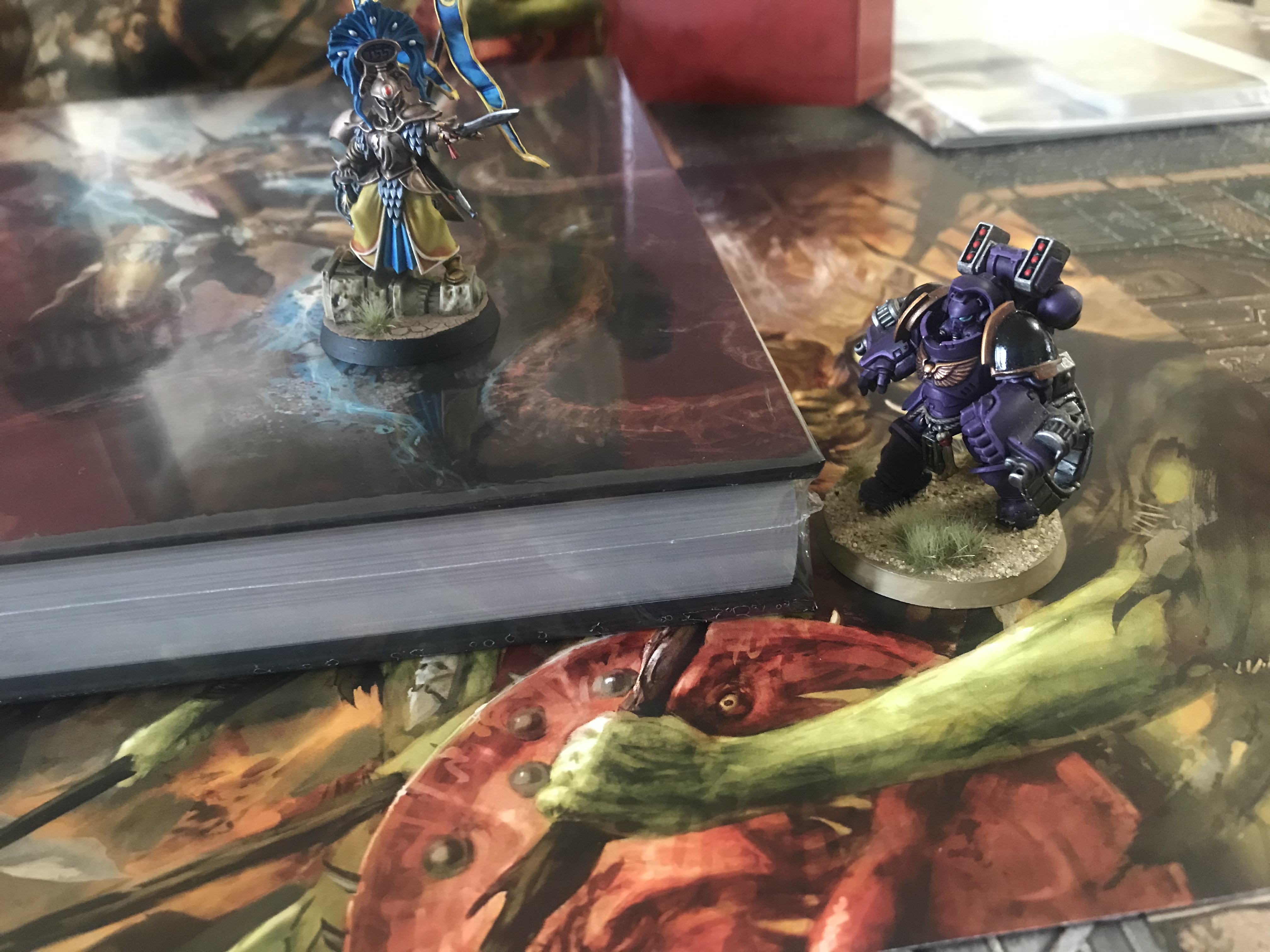This review is based off a preview copy of Dominion provided by Games Workshop.
It’s fair to say that at any give moment my brain is veritably crammed with 40K-related thoughts, and has been pretty much continously since the release of 9th Edition last year (and if we’re honest long before that). Occasionally, however, the haze does part somewhat and I briefly consider the speculative concept known as “other games”. I’m reliably informed by various members of our editorial team that they exist, and that some of them are “good” and I should “play them”.
One of those games is Age of Sigmar, and if I’m honest I’ve been curious for a while. While I heard all the bad stories about the original, that all happened while I was essentially completely out of the hobby, and by 2017 when I dived back in the trajectory was vastly more positive. By all accounts things have gone from strength to strength since then, and the volume of lavish praise for the game emanating from some segments of the community (including a growing chunk of our writing team) has grown ever louder. This plus the all-important addition of pointy elves to the game was sufficiently compelling that I even had a go at painting some miniatures for it late last year, but bounced off the complexity of the models for a faction where spamming basic infantry was (at the time, anyway) one of the key strategies. The idea of giving the game a go has sort of simmered in the background since, but with so much going on in the 40K world I’ve never quite managed to make the space for it.
Right now, it looks like the time has finally arrived. Games Workshop were kind enough to send me a copy of Dominion, and it turns out that getting sent a copy of the new and improved corebook plus 1300pts+ of an army that can be painted mostly with metalics, drybrushes and washes (yeess) and almost all wear face concealing helmets (yeeeesssss) is a powerful motivator.
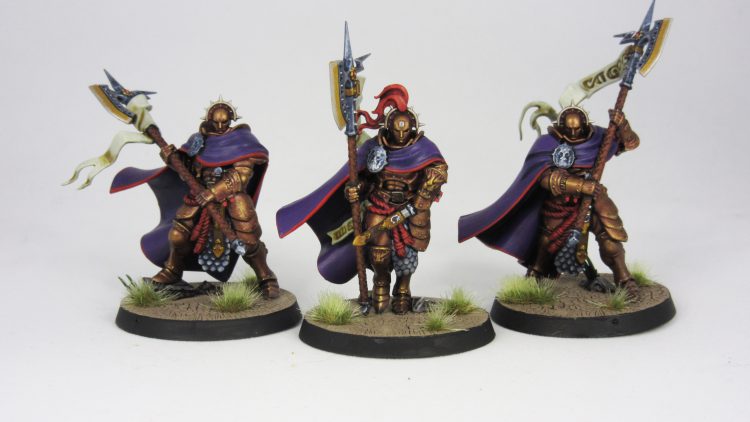
I’ve painted my first Stormcast and there’s no going back – I’m already in the process of working out where the Vindicators and Lord Imperatant fit in my painting queue alongside the Incubi and Raiders I need ready for when UK events open up, and I’ve been speculatively looking at the rest of the Stormcast range trying to work out else I might want to build out to 2000pts.
I have also been having a thorough read of the Core Book, and that’s why we’re here today. I largely write for the site in my capacity as a 40K player and analyst, and while I have been AoS-curious for a while, I’ve never read the rulebook of either previous edition. From discussions on our discord I’ve got a rough idea that there’s both a reasonable amount of overlap with 40K and some massive differences, and once rolled a few dice in a tiny demo skirmish game that I could pretty much follow, but never properly dug into how things work, never mind tried to analyse it the way I do 40K.
With 3rd Edition, and my commitment to actually try and play some games of this, that’s all changed. I’ve read the Core Rules and Matched Play Battlepack end-to-end, studied all the Datasheets Warscrolls that came in the box (plus a few more in Azyr), and you’ll be delighted to hear that I have opinions which you are now going to read. I hope you’re delighted, anyway – if you’re not I have searching questions about why you clicked on an article with this title.
Important Note
This is probably not the article to read if you’re looking for a blow-by-blow rundown of the Third Edition changes and what they mean for your army. If that’s the kind of content you crave, you should check out our Age of Sigmar 3rd Edition landing page, where our fantastic AoS team are working hard to bring you just that.
My goal here is to give you my impressions from a mostly cold read of AoS’s rules, using my experience with 40K as my benchmark rather than any previous editions. There are a few places where I’ve picked up some specifics of how things used to be, either through the general zeitgeist or from asking where there was something that seemed odd. I’ll call those out where they come up, but otherwise assume my mind is a blank canvas untroubled by AoS-specific foreknowledge, and treat my musings appropriately. Alternatively, shout furiously at the screen whenever I say something blindingly obvious. Whichever you enjoy more.
The Rules
First Impressions and Presentation

Right out of the gate the AoS team are clearly aiming squarely for my approval with this book, because I am the exact target audience for the rules numbering and I think it’s brilliant. What’s crucial, however, is that while the presentation is fairly legalistic the wording is very clear and easy to follow, especially with the choice to bold any words that have a specific rules meaning. The heavy use of italicised comments to communicate intent in the sidebars is also a masterstroke, and feels like it resulted from some very rigorous focus testing. Plenty of times I’d read a rule and go “but what happens if…?” and find the answer already waiting for me, and I strongly suspect that plenty of these were directly added in response to queries during test reads. There’s a few places where I feel like some of what’s in these comments should probably have been incorporated into the actual rules (most notably around Endless Spells), but their overall contribution is hugely helpful, and the feeling of having my rules questions anticipated and answered in real time is very reassuring.
Adopting this style was a clear risk. 9th Edition 40K got a bit of blowback from some segments of the community for its increased use of technical language, and outright numbering the rules clauses like a piece of legislation was bound to put some hackles up. Having now read them, I suspect the vast majority of people who were a bit worried when they first saw the numbering don’t need to be. It’s clear that a real attempt has been made to square the circle of needing technical, unambiguous language to support tournament play, but not wanting to create something that’s daunting to newer or less competitively minded players. The overall effect is like a synthesis of 40K’s main rules, bullet point summaries and Rare Rules, all presented in one go, and it works. Rare Rules were a very valuable addition to 9th Edition, but building that kind of commentary in up-front really helps with picking things up on a first read. Combining that with the numbering system also provides a good way of applying any FAQs needed (something else Rare Rules have helped with). I’d lay good money that we’re going to see FAQs of the format “add the following box next to rule X.Y”, and I think that’ll work well.
The only thing I don’t love about the overall presentation of the Core Rules is that I think a few additional, heftier section breaks would have been good. I’m not saying reset the numbering when you move from talking about the phases to Terrain or anything, but a part-page graphic or something to give a clear indication what there’s a context switch (and, crucially, that if you’re not interested in this bit right now you can skip on) would have been handy. It’s not a dealbreaker or anything, but if I was flicking through equivalent sections in the 9th Core Book I think I’d find it easier to land on what I’m interested in. That’s especially true because a good few of the sections towards the end are very unlikely to be relevant to players in their first few games.
Overall, that’s a definite nitpick. I love the overall style here, and I think it takes a lot of the good decisions 9th Edition 40K made and iterates on them to be even better. I firmly hope that if/when a new Edition of 40K arrives, it iterates again in turn.
Summary
- Numbered rules and comments – yes please.
- Bolded text for meaningful words – also yes please.
- Could do with better delineation of sections, especially towards the end.
Core Concepts
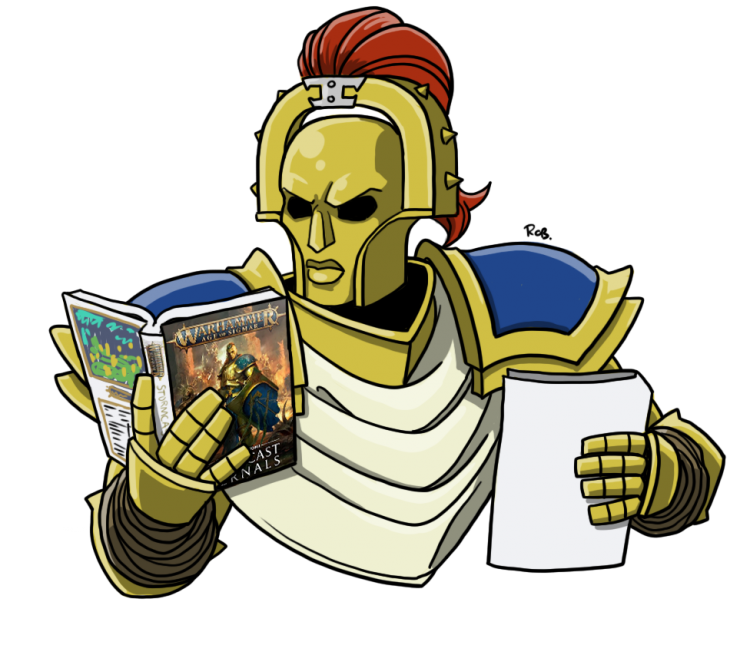
Similar to 40K, AoS kicks off its rules by defining various terms and introducing the concepts you’ll need to understand the rest of the rules (plus those from other sources like Battletomes). This was one of the best innovations 9th Edition brought to the table and it’s no different here – you quickly get clear, unambiguous definitions of basic concepts like models, armies, measurements and rolls, and some basic groundrules for how they function. Most of this won’t be surprising to anyone who’s played either 40K or (I assume) AoS before, it’s just putting stuff you already knew on the page in writing so no one can try and bail on a losing game by starting to question whether we truly know what the Battlefield is. We do. Rule 2.0 tells us.
Where this section gets interesting for me is when it tackles Unit Coherency and Abilities, both of which have some divergences from 40K, and both of which introduce some overall themes in how I think this book wants games to play out. Coherency is harsher than 40K’s version – it imports 9th Edition’s rule that models in units of 6+ have to stay in range of two buddies rather than one, but with a punishing 1″ coherency distance rather than two. This puts an extremely severe cramp on how much space horde units can take up, while also making units of 5+ large-based models extremely unwieldy. It’s the first of several things that strongly indicate that the designers want units of the default size to be the norm and massive hordes to be an exception, and I’m basically here for that overall while recognising that this is likely a bit of a blow to anyone with an existing army built around giant hordes. It may also be a bit excessively fiddly for use on the table, but that’s something I’ll want to gauge when I play, and the general feeling that they want MSUs to be viable is an active draw to me as a potential new player who definitely does not want to paint 20 of the same thing.
Abilities is the other space which felt quite novel, and this I’m overwhelmingly positive on. It expands out some definitions of what counts as “affected” by an ability and what happens when things clash, but also introduces some super handy principles and guardrails. In one of the handy comment boxes is something that’s heavily implied in 40K’s rules but never explicitly stated, to the great, great cost of those of us who “like” arguing online – while Abilities take precedence over Core Rules, those that modify Core Rules don’t bypass restrictions on those Core Rules unless they explicitly say so. This does, for my money, get slightly undermined in a few places elsewhere, with rules essentially stating “this restriction cannot be bypassed by an ability”, which you arguably don’t need to say at that point, but whatever – stating some principles for how to adjudicate edge cases is a fantastic move, and I’m guessing this extra clause appearing in a few places is designed to ensure no nasty hangovers from 2nd Edition books and Warscrolls.
The other thing we get here are a couple of guardrails – things clearly applied to try and prevent stacked nonsense combos. Only one ability can be triggered by a dice roll of a specific number, so you can’t combine three different effects that give you mortals on a six, and abilities that let you fight or shoot an additional time can never do so more than once in the same phase. I like this, and it’s another thing I could imagine seeing incorporated into 40K (e.g. “you can never improve an invulnerable save to better than 3++ unless it starts at 2++ on the datasheet”) to insure against the most annoying kinds of combo.
The only surprising absence here, and one I think was a big miss – Engagement Range. Creating a codified term for that in 9th was a fantastic move, and the concept clearly exists in Age of Sigmar (at 3″ rather than 1″), but for whatever reason exceptions and restrictions that apply regarding the space within 3″ of the enemy are just laboriously written out each time. I have no idea why – and I’m none the wiser having read the rest of the rules.
Summary
- Starting with Core Concepts continues to be the right choice.
- Unit Coherency starts a push towards a more MSU-based game, definitely appealing as a potential new player but potentially a shakeup to existing ones.
- Guardrails and principles are very welcome and hopefully keep the game cleaner.
- Decision not to adopt Engagement Range as a concept is baffling.
Priority and Battle Rounds
Ok here it is, the big one, the scary one, the thing I sort of knew was coming – the Priority Role. Rather than the same player going first in every Battle Round in Age of Sigmar, you roll off at the start of each one, and the winner gets to choose whether to go first or second. If there’s a tie, the player who went first on the previous turn has priority, and in the first battle round (at least in matched play, so for my purposes all play) the player who finished deploying first automatically has priority.
This creates the possibility of the dreaded double turn – a player goes second in one battle round, then wins the roll off for the next one so gets to take two turns back to back. This will happen about 42% of the time. This obviously creates the possibility of incredible swings and sounds completely crazy to a 40K player on first read, but there’s a couple of things going on that make it maybe more reasonable. AoS is obviously much more melee focused than 40K, and in the Fight Phase here chargers don’t automatically fight first, so the tilt of damage against you during an opponent’s turn. In addition, as we’ll get to shortly, AoS 3rd Edition gives you a lot more stuff to do during an opponent’s turn, a lot of which are powered by Command Points, and that takes us to the other big difference here. In AoS (and I think this is new for third) Command Points are doled out per battle round, and expire if you haven’t used them. That means you’re encouraged to spend big, and that’s especially true for the player who goes second in each round, who gets an extra CP for their troubles.
That inbuilt balancing factor is something I like a lot, and my general impression from the zeitgeist is that giving you more stuff to do in your opponent’s turn and more powerful ways to spend your CP is one of the big drives in this edition, but I’ll freely admit I’m still skeptical about the Double Turn as a concept. That’s partially from reading forward to the missions – Objective-based scoring is all at the end of turn rather than the end of battle round, and while I can see that lots of effort has been put in to try and give you tools to react when your opponent gets a double, in anything resembling a close game I’d still expect the second of those turns at least to be a max-point turn near every time. I haven’t seen the General’s Handbook missions yet, so it’s possible they’ve got a different structure, but if they don’t it seems like a huge missed opportunity – putting most objective scoring at the end of the battle round would be the perfect way to create more tension in the decision as to whether to take the double turn when offered.
Realistically, I’m still willing to be won round on this when I actually start playing games, and it’s fair to say that if the missions weren’t end-of-turn scoring I think I’d be happy enough had been done here, and I like what it’s encouraged the designers to do in terms of adding more interaction in enemy turns. I guess we’ll see if I end up proven wrong on this.
Summary
- Double turn make tiny 40K brain afraid.
- Extra CP for the player going second is a strong choice that I really like.
- End-of-Battle Round scoring feels like it would solve most of the concerns, and I’m curious why they didn’t go for it.
Heroes and Command Abilities
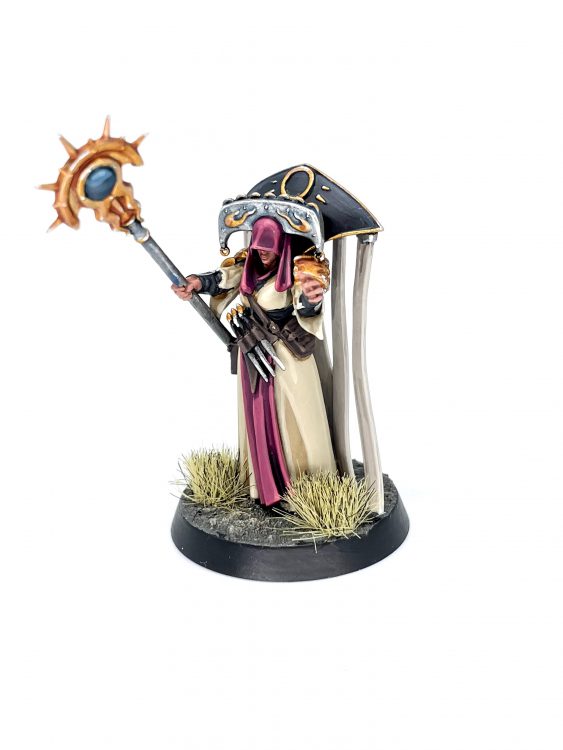
Warhammer 40K has a “Command Phase” now, but the Age of Sigmar Hero Phase came first and is clearly a much bigger deal. As well as rolling in the equivalent of the Psychic Phase (Spells and Prayers) the Hero Phase provides a window for activating many (though not all) Command Abilities, and also performing Heroic Actions.
Heroic Actions are new, is my understanding, and basically let you choose one hero to do a cool thing each turn. I like these a lot, and as well as ensuring you have something to do, there are some great safety valve mechanics here. Don’t have any wizards to stop your opponent’s spells? One of your heroes can temporarily put on robes and a wizard had and take a swing at them. Opponent tried to alpha your hero off the board and failed? Healing time. Got your general punked, thus losing one of your command points each turn? The Hero ability that gives you an extra CP becomes more reliable when your general is dead. This feels like a masterstroke all round – it gives players interesting things to do, the core choices create a whole bunch of tools to stop you getting stuck in a situation where you’re losing in an unfun way, and it opens up wide tracts of design space – I’d be astounded if we don’t start seeing faction-specific Heroic Action choices in 3rd Edition Battletomes.
Command Abilities are the other thing we’ll cover here. Technically they’re spread throughout, as there are different ones for each phase, but this feels like a logical place to hit them. I love these, and I specifically love that they’ve gone big with them in this edition. The closest analogy to these in 40K is stratagems, and they run off the same resource in Command Points. To activate a Command Ability, you spend a CP and pick a unit to receive a command. The Unit has to either be within a certain distance of a hero you choose issue that command, or have a Unit Champion to issue it directly. Assuming that the command is successfully received, some sort of effect, usually a buff will trigger.
From looking at datasheets, plenty of heroes have specific Command Abilities that only they can activate, but the big news as you read through the Core Rules is that you get a strong set of universal choices. This is one of the places where I went away and had a brief look at the set of these in Second Edition, because the stuff these let you do is so impactful that I felt like I’d have been aware of them if they were so important in the old version. Sure enough, the set of Core Options is substantially bigger, and substantially more potent. On the “make maths good” side of things you’ve got straight up “+1 to hit for a phase”, which any 40K player will recognise as absolutely worth one CP, and the probably even spicier “+1 to saves” (which I vaguely get the impression might be Edition-defining by its very existence). On the more tricky, nuanced end of things, you get the ability to move d6″ in response to an opponent ending a move nearby (the eyes of tournament players everywhere just lit up) and do a souped up version of Overwatch when an opponent charges you. There’s a few other things that won’t surprise 40K players (charge re-rolls, morale auto-passes) but it’s clear that having these around, and being encouraged to use them a lot by the Command Point system is going to have a massive impact on how AoS plays.
Honestly? I love it. Mastering the use of these looks crucial to success in the new Edition, and I can’t wait to have a go with them. They’re also a big part of why I’m more willing to give the Double Turn a chance compared to what I’ve heard of it in precious Editions. I don’t necessarily think that this is something that you’d import wholesale into 40K, because the much more faction-specific Stratagems are also something I enjoy a lot, but I’m extremely keen to see how these play out. My nuclear hot, searing take is that the +1 Saves ability here (especially because there’s a generic +1 Save spell too) is going to be a huge shakeup to how the game’s balance works, and make anything that’s starting out on a 3+ (or even 2+) substantially more exciting by default. Oh all those Stormcast I’m painting have 3+ or better saves? What a weird coincidence. How did that happen.
Summary
- Yes, yes, yes.
- Heroic Actions open up loads of design space and create healthy comeback/safety valve mechanisms.
- Command Abilities appear to be the thing they’re using to centre the Edition and differentiate from 40K, and I’m very here for trying the game they create.
Move, Shoot, Charge, Fight
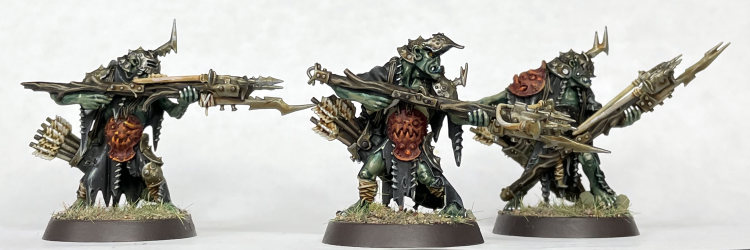
This section is going to be bullet points, because while there are differences here, nothing’s going to massively shock a 40K player. I still like some of the small changes, but they aren’t game re-defining like Command Abilities are.
- Movement measuring uses a clever, simplified path-drawing method that avoids any of the issues with measuring segments of a move or accounting for rotation. It does appear to let large-based models pull off very tight cornering, but I’d basically love to see this brought across to 40K despire that.
- On the flip side, FLY movement up to raised terrain uses diagonal measurement through the air. The absolute maniacs. I don’t hate hate this, but it does create a weird situation right in the core rules where you could theoretically have a tall, solid wall that a FLY model could cross (they still ignore terrain if they’re just moving horizontally) but not land on top of.
- Hits and wounds always use fixed target numbers on Warscrolls, and damage spills over between models. This makes the output of units far more predicatable and is probably a boon overall for balancing. I don’t think you could import this straight into 40K, because Tanks being hard to kill is a crucial part of the theme of that game, but it makes sense in a setting without them.
- The big upside of the above is that it allows Fast Dice to be an actual, supported part of the core rules, as there’s vastly reduced scope for things to change in the middle of a batch. This is obviously great for speeding up play, and combines with what appears to be a general trend for modifiers rather than re-rolls to significantly speed up resolution.
- As mentioned earlier, in the Fight Phase there’s no automatic Fight First for chargers. The active player does get the first pick, but after that it’s a full blown swirling melee, so engaging on multiple fronts is always going to be a risk.
The one slightly bigger thing to call out is that there don’t appear to be any invulnerable saves in AoS – instead, “Feel No Pain” style rules get codified into the “Ward” rule. That makes a lot of sense, since as mentioned earlier Rend (the equivalent of AP) seems to be a lot rarer, so an invuln on top of a 3+ save would be pretty pointless. A good Ward value is also going to be a bit less swingy than a good invuln against high-damage attacks, making it feel a bit more surmountable. The only thing I don’t like is that the timing and wording on when Ward actually happens are kind of weird. You’re only allowed one Ward effect against each incoming roll, but the way it’s worded makes it unclear how that overlaps with bodyguard style abilities like those on Stormcast Praetors. It also appears to assume there will never be a sitaution where one model in a unit has Ward and the rest don’t, and if that assumption lasts a whole edition of rules writing I will have to find some sort of hat to consume. I think centralising this is a good call, but it’s one of the few places where I think the overall clarity breaks down a bit, and expect it to see some early FAQs.
Monsters and Mages, Oh My
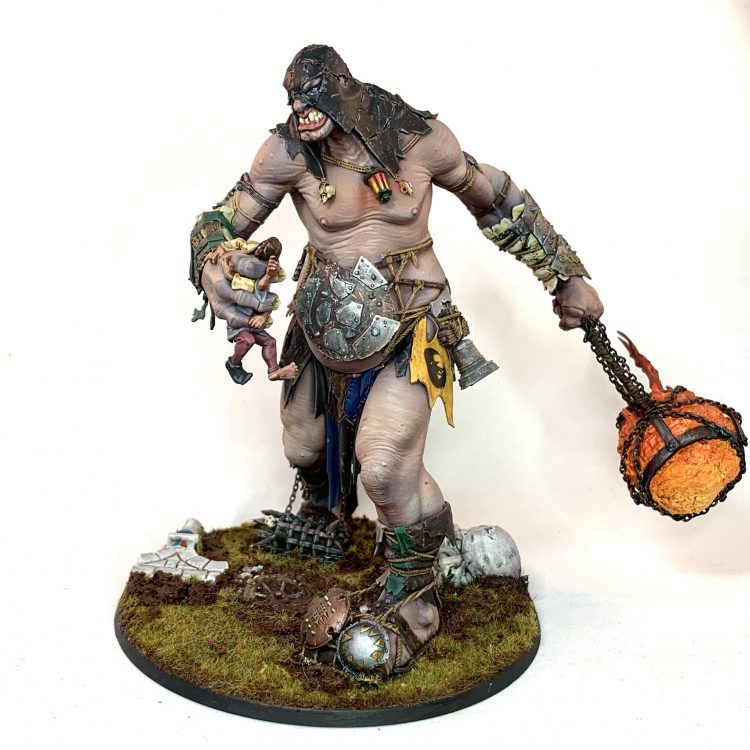
Wizards, Priests and Monsters all get some extra rules over and above your regular slobs. Priests and Wizards both invoke supernatural effects (directly equivalent to psychic powers and litanies in 40K), and in the case of Wizards can also meddle with the opponent’s attempts to do the same. They can also call upon lasting supernatural effects in the form of Invocations or Endless Spells, which are things you pay for in your list that are represented by a model and kick around on the battlefield doing cool stuff until dispelled. That’s the theory anyway – these were pushed heavily at the start of Second Edition, but my vague sense is that they fell into that awkward balance spot where they were clunky enough to use that they had to be doing something spectacularly unfair before you’d take them. From what I’m seeing here, there’s maybe some smoothing around the edges, so hopefully they’ll be more of a routine part of the game – they’re a really cool concept (though how much they matter is hard to gauge from the Core Rules alone).
Monsters, meanwhile, get something similar to Heroes in that they get to perform a Monstrous Rampage at the end of the charge phase. This is another angle for some safety valves, because there’s options here for shutting down enemy Command Abilities and smashing up Faction Terrain. It means that choosing to bring one monster along for the ride if either of those cause your army problems is always an option, and having that built in to the game up front is good. I do vaguely feel like playing against monster heavy armies might get a little tiresome, but my understanding is that points are generally trending upwards a bit in the new Edition, so that probably won’t come up too often.
Army Construction, Battalions and Enhancements
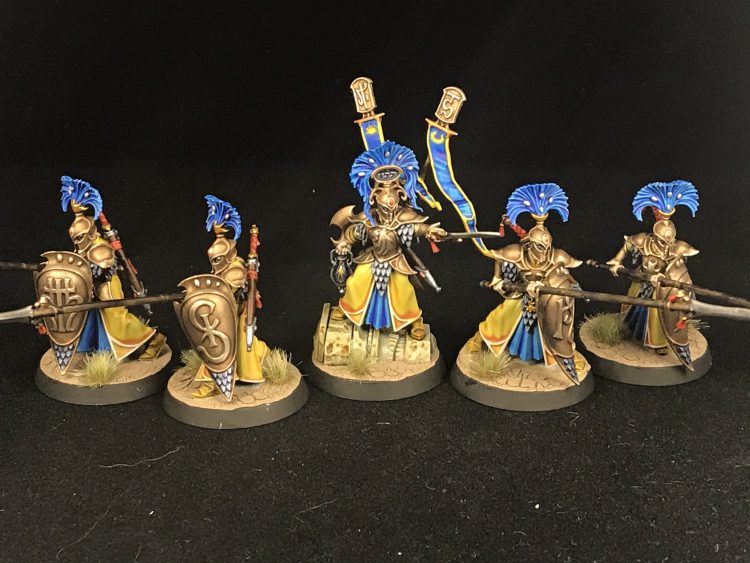
The last thing to talk about before finishing with a look at the missions is army construction. This comes with a few facets, several of which map quite neatly onto 40K concepts. While there’s nothing quite as complicated as the battlefield role system, some units are designated as having certain types which are either limited (in the case of Leaders, Behemoths, Artillery and Endless Spells/Invocations) or mandatory (Battleline, your Troops equivalent). This is all pretty sensible stuff, which puts at least some level of a cap on how skewed armies can be (though I’m aware that “make stuff battleline” is a fairly common ability).
The more interesting cap here is in “Reinforced Units”, which is apparently new. A Reinforced Unit is one with double the normal number of models (or in the case of Battleline, up to triple if you Reinforce twice) at twice the cost. No buying extra models one at a time here – you either get the box size or twice that, and you’re quite aggressively limited in how many units you can bulk up. This is another thing that gives a strong sense of intent – it looks like the designers really want default-sized units to be the, well, default, and I think that’s good for the game overall. It was very noticeable when painting up my Praetors that, compared to the Skorpekh Destroyers from Indomitus, I’d be much more likely to be able to throw them onto the table as-is and expect them to do something. We’ll see if this actually lands in practice, or if it’s one of those things where the books for some factions end up doing a reverse ferret on the core restrictions, but it certainly could be a very good thing.
Next up we have some things that will feel pretty familiar to 40K players in Battalions and Enhancements. Battalions (or at least the Core Battalions seen here) are similar to Detachments, but an optional overlay for the units already in your army rather than something every unit has to be arranged into. If you have the right units to fill out one of these you get some bonuses, ranging from extra Enhancements to once-per-game uses of Command Abilities for free. This is kind of fine, but I’ll admit it feels a little bit behind the design curve compared to the rest of the book. The benefits are clearly worth it and you’ll definitely use these, but there’s an extent to which some of the best of these don’t ask too much of you, and you’d be frankly silly to leave the value they bring on the shelf. Not quite enough tension in the decisions here for my liking.
Finally, Enhancements – your equivalents of Warlord Traits, Relics and Psychic Disciplines, plus an AoS only thing known as Triumphs. You get to pick some of these by default, and can get more from Battalions, but what’s quite different from 40K is that there’s a number of generic options right here in the book that any faction can use. I like the choice to do this – where a concept is going to be universal to all future books it makes sense to have examples in-lined in the main rules. I’m a little surprised by how swingy a few of the options are though – the Relic that turns anyone into a Wizard stands out as something that could see a lot of use given how powerful the default Arcane Shield spell is. Triumphs are the one thing here that I must admit I didnt really “get” on a readthrough and ended up asking the AoS writers about. Good news – they’re currently weird and niche, but used to be even more weird and niche, so I think that’s an improvement (?). As they work out now, if you sandbag your army to be like 10pts below the limit, you’ll sometimes get a once-per-game effect. OK. Not sure it’s really worth the mental bandwidth they add, but whatever.
Summary
- Army contruction has some sensible limitations on it.
- Hordes are capped and somewhat discouraged by the Reinforced Units mechanic.
- Battalions reward you for building lists in ways you were probably gonna anyway.
- Enhancements work much the same as in 40K, but it’s good to have them codified in the core.
Missions
Last of all, missions – where there’s stuff I love and stuff I hate. I’m talking abotu the Core Book Matched Play Battlepack here, so things may be different in the General’s Handbook.
The main scoring route in the missions isn’t going to feel too unfamiliar to 40K players. There are objectives, and you get victory points when you hold one, two, or more than your opponent does. There are also alternative scoring mechanics filling the role of Secondary objectives. These I really like. On your Roster, you choose one “Grand Strategy”, a game-long objective that you get VP for achieving. There aren’t that many choices in this pack, but I’m assuming more will be added both in the GHB and battletomes, and it’s something I’m interested in seeing more of. There’s also a turn-by-turn Secondary mechanic in Battle Tactics. You pick one of these (from a list of six) in each Hero Phase, and score points for achieving it that turn. Each choice can only be picked once per game. I love this, it’s a nice halfway house between pre-game Secondary picks and Maelstrom-style missions that is simple and intuitive, but still has depth.
What I don’t like is end of turn objective scoring. Come on. We know this is bad. We’re past this. End-of-Battle-Round (probably the right choice for AoS) or start-of-turn options are right there. This particularly stings here because you’ll know ahead of time if you’re going to have priority round one during deployment, and on two of the three core missions you can trivially guarantee that you’ll score maximum objective points and tick off one of the more challenging Battle Tactics right out of the gate (unless your opponent has a way to move in your turn beyond the Command one, which you can play around). There’s a degree to which moving up hard like that opens you up to a counterattack, but I’ll say I’m skeptical that there isn’t a risk of a snowball effect here. I’ll certainly be interested to see if the GHB missions make any different choices, and to see how this plays out in practice.
Overall Thoughts
I really, really like what I’m seeing here, and look forward to giving it a proper try. The thing that speaks to me most is the stuff around Command Abilities and the Hero Phase, which creates a bunch of interesting gameplay dynamics while also further carving out a distinctly different style of play to 40K. Not necessarily better or worse mind, just different – and for me that’s a positive. If this game was just 40K with a different skin I don’t think I’d be motivated to play it. I love 40K very much and am certainly not jumping ship or anything, but there looks to be a really nice niche being carved out here for a game more focused on glorious golden heroes fighting swirling, cut-and-thrust brawls, and I’m very excited to try it. Thanks again to GW for sending me a copy of Dominion, and I guess maybe look forward to seeing a bit more AoS writing from me once my army is painted up.
If you have any comments, questions or suggestions, give us a shout at contact@goonhammer.com.
